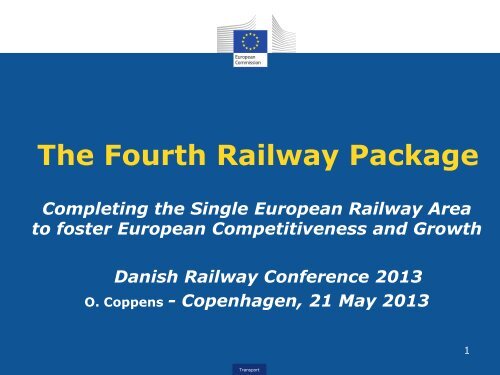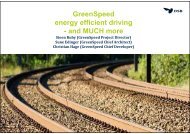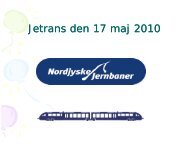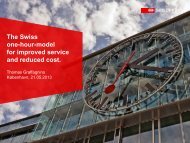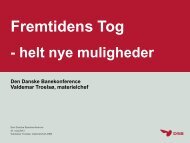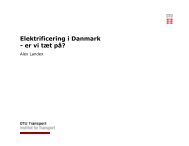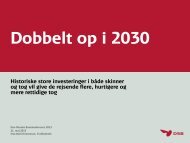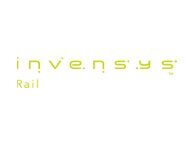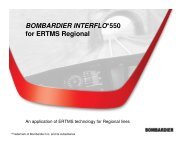The Fourth Railway Package
The Fourth Railway Package
The Fourth Railway Package
- No tags were found...
Create successful ePaper yourself
Turn your PDF publications into a flip-book with our unique Google optimized e-Paper software.
<strong>The</strong> <strong>Fourth</strong> <strong>Railway</strong> <strong>Package</strong>Completing the Single European <strong>Railway</strong> Areato foster European Competitiveness and GrowthDanish <strong>Railway</strong> Conference 2013O. Coppens - Copenhagen, 21 May 20131Transport
Characteristics of the <strong>Railway</strong> SectorQuality of rail services in the EU - there is room forimprovement• Passenger modal share static at 6% (despite rapid growth in highspeed rail)• Consumer satisfaction poor (rail services ranked 27 th of 30 serviceindustries)• 54% of EU citizens not satisfied with national/regional rail services2Transport
Characteristics of the <strong>Railway</strong> SectorGaps in operational efficiency• Productivity can be improved in several railway undertakings• Uneven usage of rolling stock and infrastructurePublic finances - important amounts devoted to rail:• Public infrastructure investment 25 billion EUR in 2009• Public subsidy for Public Service Obligations of 21 billion EUR in2009Current economic context - efficiency of public funding3Transport
Characteristics of the <strong>Railway</strong> SectorSingle European Rail Area:• 94% of all passenger-km are domestic• Internal market still fragmented along national lines - some railmarkets fully open, some partly open, some closed…• Growing divergence of efficiency and satisfaction between MS -best performers are performing even better, laggards are fallingbehind• Liberalised markets are best performers in most efficiency andsatisfaction indicators4Transport
Characteristics of the <strong>Railway</strong> SectorSingle European Rail Area:• Long and costly authorisation procedures for rolling stock andundertakings• Challenges of infrastructure governance - efficiency• Challenges of infrastructure governance - equity of access5Transport
Why do we need to act?• Improve competitiveness of rail with other modes in order toincrease the market share of the most environment-friendlymode of transport• Spend public money more efficiently on public rail transportservicesHow do we move forward?• Encourage market entry by reducing administrative and technicalbarriers• Open domestic rail passenger transport to competition• Encourage market entry and ensure non – discrimination througha better governance of the infrastructure6Transport
<strong>The</strong> Three Pillars of the <strong>Fourth</strong> <strong>Package</strong>1. To establish consistent approvals procedures for railinteroperability and safety2. To open domestic passenger markets3. To create better structures and governance forinfrastructure managers7Transport
Core legislative initiatives of the <strong>Fourth</strong><strong>Railway</strong> <strong>Package</strong>Technical pillar• Modification of the European <strong>Railway</strong> Agency Regulation• Modification of the Rail Interoperability Directive• Modification of the Rail Safety DirectiveOpening of domestic markets• Modification of the Recast of 1st package• Modification of the Regulation on Public Service ObligationsGovernance of infrastructureModification of the Recast of 1st package8Transport
EU decision-making process: ordinary procedure• European Commission adopts proposal• European Parliament(EP) proposes amendments• Council of European Union (EU Member States) proposesamendments• EP & Council negotiate and vote proposals with the view to adoptthem9Transport
How was the Commission proposal prepared ?• Consultation of a high number (nearly 500) of stakeholders• Eurobarometer survey: 25.000 citizens in 25 Member States• Stakeholders workshops and conferences• External support study• Stakeholders studies and position papers• 3 Impact assessments10Transport
<strong>The</strong> Three Pillars of the <strong>Fourth</strong> <strong>Package</strong>1. To establish consistent approvals procedures for railinteroperability and safety (‘technical pillar’)2. To open domestic passenger markets3. To create better structures and governance forinfrastructure managers11Transport
Technical pillar – main problemsMain problems:Long and costly procedures & access barriers, caused by: Ineffective functioning of national railway institutions Discrimination against new entrants Patchwork of national regulatory regimes and rules12Transport
Technical pillar – concrete examples ofproblemsFacts and figures: fee of a safety certificate varies from 0€ up to 70 000€ andtotal costs for an additional vehicle authorisation between 900000€ up to 2 €M per locomotive type procedure to receive an authorisation for a railway vehicle canlast up to 2 years staff involved in interoperability issues varies from 1 person incase of smaller Member States up to 162 in Germany - someNSAs are understaffed in some national authorities a large part of staff is onsecondment from incumbent operators – risk to theirindependence and increased risk of discrimination13Transport
Technical pillar - new ERA RegulationNew ERA Regulation to allow ERA and national safety authorities toshare competenciesNew powers for ERA:Issuing single certificates and vehicle authorisationsStrengthened control by ERA over NSAsStrengthened role for ERA in the process of removal ofunnecessary national rules14Transport
Technical pillar - revision of Safety andInteroperability DirectivesWhy amend the Safety Directive?‣ Migration towards a single safety certificateWhy amend the Interoperability Directive?‣ Vehicle Authorisation for Placing on the Market (POM)15Transport
• Technical pillar - Single Safety Certificate <strong>Railway</strong> Undertakings have to apply for a Single Safety Certificate toERA, valid at the EU level ERA grants the Single Safety Certificate if the RU has established itsSafety Management System (SMS) in accordance with all requirements RU informs NSA 3 months before start of operation. NSA can expressdoubts and inform ERA that takes necessary measures ERA and NSAs shall cooperate in the supervision of the Single SafetyCertificate16Transport
Technical pillar - Interoperability• Placing on the Market of mobile subsystems and vehicles(Articles 19-20) New notion of a single Authorisation for Placing on the Market ofVehicles, issued by the European <strong>Railway</strong> Agency. New notion of Placing on the Market of mobile subsystems andvehicles, which can be carried out by both railway undertakings andmanufacturers.17Transport
Technical pillar - InteroperabilityPlacing in Service of Vehicles (Article 21) <strong>Railway</strong> undertakings are responsible for the placing in service ofvehicles. <strong>The</strong>refore, railway undertakings must check the technicalcompatibility of the vehicle with the route and the safety integration ofthe vehicle into the system it is meant to operate in. <strong>Railway</strong> undertakings must communicate their decisions on the placingin service of vehicles to the Agency, the infrastructure managers and thenational authorities concerned.18Transport
Opening domestic rail markets: EU market todayCommercial services (1/3 of EU passenger-km): long-distancePublic service obligations (2/3 of EU passenger-km): regional/S-bahnA variety of market structures across Europe:19Transport
Opening domestic rail markets: how?Open access for commercial services - RecastCompetitive tendering for public service obligations - PSORegulationEnsure that open access can be restricted if it compromises the« economic equilibrium test » of PSOs - RecastNon-discriminatory access to ticketing - RecastEase access to rolling stock - PSO Regulation20Transport
Opening of domestic rail markets:Combination of PSO tendering and open access is needed to fully open markets21Transport
Opening domestic rail markets: consultationConsultation process: railway stakeholders, Eurobarometer, SocialDialogue Committee, Committee of the RegionsMain results:• 71% of Europeans in favour of more competition in rail• 60% of rail stakeholders in favour of a combination of both openaccess and competitive tendering for PSOs• 55% rail stakeholders favour "Open access subject to viability ofPSCs"• Social Partners prefer rather more investment in rail• Regional authorities polarised concerning market access22Transport
Opening of domestic rail markets: analysis of impactsMain impacts of the combination of PSO tendering and open access:• Benefits of up to 29 billion EUR – up to 43 billion EUR if combinedwith vertically seperated structures• Savings of 20% for public authorities• Prices and fares – downward pressure on fares in commercialservices (ex. Rome-Milan), no impact for PSO fares• Increase of rail services - better usage of infrastructure• Differentiation in services - low-cost services, better qualityTransitional phases soften social impact as 30% of rail workforce toleave in the next 10 years23Transport
Domestic Rail Passenger Market Proposals -modification of Recast 1st <strong>Package</strong>• Art. 10: Open access for all EU operators to all markets, includingdomestic passenger markets• Art. 11: Right of access may be limited to protect economicequilibrium of public services (to contain "cherry-picking")• Test to be done by regulators, as for international services• Art. 13a: Possibility of integrated ticketing schemes betweenpassenger operators, in a way that does not distort competition24Transport
Amendment of PSO Regulation 1370/2007Definition of Public Service Obligations (PSO)/scope of PublicService Contracts (PSC)•Competent authorities (CA) to define objectives of public transportpolicy in public transport plans•PSO to be consistent with public transport plans•Stakeholders to be consulted on draft public transport plan anddraft PSO specification•Specifications of PSO and related compensation of the net financialeffect of complying with them to: Achieve public transport policy objectives most cost-effectively Financially sustain provision of public passenger transport in the long term25Transport
Amendment of PSO Regulation 1370/2007Definition of Public Service Obligations (PSO)/scope of PublicService Contracts (PSC)For rail only:•Compliance with assessment based on criteria andprocedure controlled by rail regulatory body•Maximum annual volume of PSC (in terms of train-km)higher value of either 10 million or 1/3 of total national railpassenger transport volume under PSC26Transport
Amendment of PSO Regulation 1370/2007Award of PSC•Deletion of Art 5(6) mandatory competitive award for railtransport•Other possibilities of direct award (internal operator, small scalecontract, emergency measure) are not modified•Threshold for small scale PSC in rail: €5.000.000•CA to make available all relevant information for establishing a bid(passenger demand, costs, revenues, rolling stock specifications,etc.)•Possibility to request for the transfer of staff27Transport
Amendment of PSO Regulation 1370/2007Award of PSC• Mandatory tendering for rail from 3 December 2019• Transitional period until 31 December 2022 for rail PSCdirectly awarded between 1 January 2013 and 3 December2019• In order to increase competition CA may decide beforelaunching the tender procedure to limit the number ofcontract lots to be awarded to the same railwayundertaking28Transport
Amendment of PSO Regulation 1370/2007Rolling stock•Competent authorities to ensure fair access to rolling stock so thatnew entrant operators are able to take part in tenders•Where there is no well functioning market for rolling stock, CA totake the residual value risk of the rolling stock, if operatorsintending to participate in tender request this.•CA can choose most appropriate means to comply with thisrequirement while respecting EU law (state aid rules): managing its own fleet, providing a bank guarantee, take-over guarantee•Commission to adopt implementing measure defining details ofprocedure to be followed (introduction of committee procedure inRegulation - SERAC)29Transport
Infrastructure governance: current problemsEfficiency challenge:•Infrastructure manager as natural monopolies may lack responsiveness to customers'needs•Insufficient incentives for infrastructure managers (IM) to reduce costs and improveservices•Lack of cross-border co-operationEqual access challenge:•Conflict of interest of integrated IMs, having to grant non-discriminatory access to newentrants and, at the same time, take account of interests of a rail holding•Discrimination opportunities•Lack of financial transparency/cross - subsidisation30Transport
Infrastructure Governance: modifications toRecast 1st package• All infrastructure management functions in the same hands(unified IM)• Coordination body for infrastructure managers and users• Establish EU network of IM's for international coordination• Institutional separation of infrastructure and transport operationsis the solution by default• Possibility to keep integrated structure only under strictindependence rules (based on the experience of the ITO model inEnergy) and with possibility for other MS to block access ofintegrated operators31Transport
Infrastructure Governance: modifications toRecast 1st package• Art. 63(1) of Dir. 2012/34/EU: Rendez-vous clause• Art. 7: Infrastructure managers to fulfil all necessary functions• Art. 3(2): Definition of the functions: development, operation,maintenance• Art. 7: Preferred model institutional unbundling, no return to integrationafter entry into force of the Directive• Art. 7a: Effective independence of an IM within a vertically integratedundertaking: legal independence, no mutual shareholding, strict rules forfinancial relations32Transport
Infrastructure Governance: modifications toRecast 1st package• Art. 7b: Independence of staff and management:- Following closely Annex V of COM189(2006) and Chinese walls ofDirectives 2009/72 and 2009/73- In addition rules on remuneration of managers• Art. 7c: Verification of compliance- Upon request of a MS or ex officio, Commission verifies whether 7a and 7bare implemented and this ensures level playing field and absence ofcompetition distortion• Art. 7d: Coordination Committee for the network• Art. 7e: European Network of Infrastructure Managers33Transport
Conclusion• Initiatives are mutually beneficial and re-enforcing• Will enhance modal shift• Removing discrimination and conflicts of interest• Improve value through competition• Make industry more responsive to customer needs• Increase demand for skilled workers• Create conditions for growth in the railway sector• Initiatives are coherent with the fundamental principles ofestablishing a single market and subsidiarity34Transport


